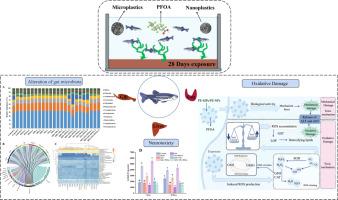环境PFOA和聚乙烯微/纳米塑料对成年斑马鱼(Danio rerio)慢性联合毒性机制的探讨
IF 4.3
2区 环境科学与生态学
Q1 MARINE & FRESHWATER BIOLOGY
引用次数: 0
摘要
在水产养殖中,特别是在依赖先进水处理技术的循环水养殖系统(RAS)中,塑料颗粒和新出现的污染物对环境造成的破坏程度受到限制,因为对这些污染物在真实环境条件下对代表性鱼类的慢性综合毒性认识不足。本研究探讨了在模拟RAS暴露情景的水生微观系统(AMS)中,聚乙烯微塑料(PE-MPs)、聚乙烯纳米塑料(PE-NPs)和全氟辛酸(PFOA)在环境相关浓度下对成年斑马鱼的综合毒性作用。PE-MPs、PE-NPs和PFOA的联合暴露表现出时间依赖性的毒性模式:在7天后对斑马鱼的鳃和肝脏产生协同作用,随后在28天后出现拮抗相互作用。MPs通过机械损伤和脂质过氧化机制诱导的肠道毒性高于NPs。单独暴露和联合暴露都会引起斑马鱼肠道的结构改变,与NPs相比,MPs引起更严重的绒毛萎缩和杯状细胞减少,而共同暴露加剧了这些病理变化。值得注意的是,PFOA引发肠道和肝脏组织乙酰胆碱上调,显示出比在鳃系统中观察到的更强的神经毒性影响。此外,MPs + PFOA和NPs + PFOA的共同暴露导致斑马鱼肠道中梭杆菌的丰度增加,从而增强了它们对致病性感染的易感性。这些发现突出了封闭水产养殖环境中微塑料- pfoa相互作用的复杂时间动态和组织特异性风险,为优化RAS水管理策略以应对新出现的污染物混合物提供了重要见解。本文章由计算机程序翻译,如有差异,请以英文原文为准。

The exploration of chronic combined toxic mechanisms of environmental PFOA and polyethylene micro/nanoplastics on adult zebrafish (Danio rerio), using aquatic microcosm systems
Understanding the extent of environmental damage caused by plastic particles and emerging pollutants in aquaculture, particularly within recirculating aquaculture systems (RAS) that rely on advanced water treatment technologies, is constrained by insufficient knowledge regarding the chronic combined toxicity of these contaminants on representative fish species under real environmental conditions. This study investigates the combined toxic effects of polyethylene microplastics (PE-MPs), polyethylene nanoplastics (PE-NPs), and perfluorooctanoic acid (PFOA) on adult zebrafish at environmentally relevant concentrations in aquatic microcosm systems (AMS) simulating RAS exposure scenarios. The combined exposure to PE-MPs, PE-NPs, and PFOA exhibited time-dependent toxicity patterns: synergistic effects on zebrafish gills and liver after 7 days, followed by antagonistic interactions after 28 days of chronic exposure. MPs induced higher intestinal toxicity than NPs through mechanical damage and lipid peroxidation mechanisms. Both individual and combined exposures caused structural alterations in zebrafish intestines, with MPs provoking more severe villi atrophy and goblet cell reduction compared to NPs, while co-exposure exacerbated these pathological changes. Notably, PFOA triggered acetylcholine upregulation in intestinal and hepatic tissues, revealing stronger neurotoxic impacts than those observed in gill systems. Additionally, the co-exposure to MPs + PFOA and NPs + PFOA led to an increased abundance of Fusobacterium in zebrafish intestines, thereby enhancing their susceptibility to pathogenic infections. These findings highlight the complex temporal dynamics and tissue-specific risks of microplastic-PFOA interactions in closed aquaculture environments, providing critical insights for optimizing RAS water management strategies against emerging contaminant mixtures.
求助全文
通过发布文献求助,成功后即可免费获取论文全文。
去求助
来源期刊

Aquatic Toxicology
环境科学-毒理学
CiteScore
7.10
自引率
4.40%
发文量
250
审稿时长
56 days
期刊介绍:
Aquatic Toxicology publishes significant contributions that increase the understanding of the impact of harmful substances (including natural and synthetic chemicals) on aquatic organisms and ecosystems.
Aquatic Toxicology considers both laboratory and field studies with a focus on marine/ freshwater environments. We strive to attract high quality original scientific papers, critical reviews and expert opinion papers in the following areas: Effects of harmful substances on molecular, cellular, sub-organismal, organismal, population, community, and ecosystem level; Toxic Mechanisms; Genetic disturbances, transgenerational effects, behavioral and adaptive responses; Impacts of harmful substances on structure, function of and services provided by aquatic ecosystems; Mixture toxicity assessment; Statistical approaches to predict exposure to and hazards of contaminants
The journal also considers manuscripts in other areas, such as the development of innovative concepts, approaches, and methodologies, which promote the wider application of toxicological datasets to the protection of aquatic environments and inform ecological risk assessments and decision making by relevant authorities.
 求助内容:
求助内容: 应助结果提醒方式:
应助结果提醒方式:


